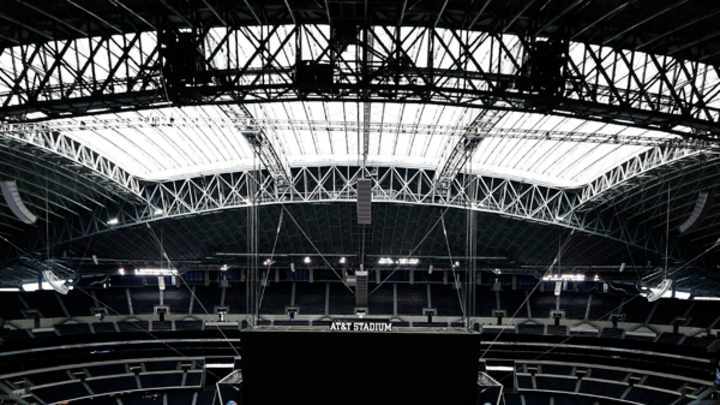Final Four road leads to gates of nation’s largest indoor stadium

Workers assemble the NCAA's Final Four floor at AT&T stadium in Arlington, Texas (Ron Jenkins/Fort Worth Star-Telegram/MCT via Getty Images).
Think of AT&T Stadium, home of the Dallas Cowboys, as one ginormous living room. One, where on Saturday and Monday for the NCAA’s Final Four, 77,200 can gather in the world’s largest column-free room to watch hoops in a makeshift basketball configuration.
The venue, which opened in 2009, is certainly better known for its football, as the home of the Cowboys and the host of the 2011 Super Bowl. But it also can be basketball-friendly, having hosted the NCAA tournament's South regional last year.
To make it a viable basketball venue, the NCAA has brought in about 16,500 temporary seats to surround the Final Four floor placed at the center of the field. Those temporary seats actually drape over about 9,500 permanent seats to more seamlessly mesh the lower bowl with the temporary structures while keeping sight lines at a premium.
Those tricky sight lines also require the NCAA to raise the floor 30 inches, similar to what we saw last week in Indianapolis’ Lucas Oil Stadium.
With seats sliding well inside the traditional football bowl, the NCAA needed to augment the 160-foot-long fabled video board with a temporary video board hanging off the main 1.2 million pound structure and angled for the benefit of the lower-bowl fans.
Whereas the NCAA kept capacity at the Midwest Regional in Lucas Oil Stadium last week under 40,000, they decided to allow 77,200 in AT&T Stadium. Some of those seats, though, may have a better view of the building’s architecture than the actual game.
The HKS Architects-designed venue goes columnless with two nearly 300-foot-tall and 1,290-foot-long steel arches serving as the main structural element for the 3.1 million square feet of space. These parallel-running arches also create “monumental entry doors” on either end. Above the entries, five 38-foot glass panels that take 18 minutes to open and close give us the largest operable glass doors in the world.
In a design resembling the old Cowboys’ stadium, AT&T Stadium has a hole in the roof, but this time with a retractable component that makes the Final Four a possibility.
Along with the grandeur within AT&T Stadium, the NCAA has planned a Tipoff Tailgate for ticketed fans with food, beverage and live music offerings for those who want to arrive to the venue well in advance of the on-court action. The NCAA hopes to turn AT&T Stadium into the world’s largest living room, but this time with quite a party deck out back. This is, after all, the Final Four in the nation’s largest indoor stadium.
Tim Newcomb covers stadiums, design and gear for Sports Illustrated. Follow him on Twitter at @tdnewcomb.

Based in the Pacific Northwest, Tim Newcomb covers stadiums, sneakers, design, training and technology across all sports.